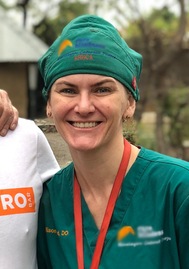“We want to focus on quality outcomes, because if we’re not giving good care, then what’s the point of all this?”
This question motivated Dr Allison Jarstad, a Global Ophthalmology Fellow for the Himalayan Cataract Project (HCP) volunteering in Ethiopia, to pilot a post-operative quality assessment program using QuickSee on patients undergoing cataract surgeries.
Since 1995 HCP has screened over 5 million people in 16 countries, and performed almost 450,000 surgeries to restore sight. (HCP estimates 18 million people are needlessly blind due to cataracts.) They have pioneered models and technology that enable swift, safe cataract surgery for just $25 per patient, and they partner with in-country organizations to build local care capabilities.
Due to the challenging circumstances of their patients—usually poor, rural, and living without modern amenities or services—it’s difficult for HCP to know precisely what long-term outcomes they achieve. Unlike in highly developed communities, follow-up examinations are rare. “In a developing country, where there’s very little infrastructure, people sometimes must walk days and days to get to the surgical outreach post, led by their children,” said Dr Jarstad. “So one of our goals for the next two years is to find innovative ways gather outcomes data.”
Related:
Scaling a solution to the global burden of uncorrected refractive error
Restoring vision where much was lost
20/20 vision for eyes—and lives
Dr Jarstad used QuickSee during her mission in Ethiopia in spring 2019. She and her team used the handheld autorefractor to measure refractive errors in patients’ first day after surgery. “It gave us a great indicator on how we were doing,” she recalled. “It was useful to get immediate data in the field.” In about six days, the HCP team performed 1,664 cataract surgeries.
Though immediate results are good to have, Dr Jarstad, her colleagues in HCP, and their local partners realize such sensitive procedures can have results that change over time. “Obviously a lot of these patients could experience refractive errors, so we are trying to find creative ways to capture that information, and to expand services to the patients.” She believes ophthalmic nurses, equipped with QuickSee, could make trips through communities for follow-up examinations and bring data back to a lab, so new eyeglasses can be produced to fine tune patients’ vision. “It’s not outrageous…I can imagine it happening in the near future.”
Read more about Dr Jarstad’s experience as an HCP Global Ophthalmology Fellow.
*The intended use of QuickSee is to objectively measure a patient’s refractive errors, to provide a starting point for subjective refraction performed by a vision care professional.
Volunteer for the Himalayan Cataract Project www.cureblindness.org
Allison Jarstad, D.O.

Please note: Our Privacy policy and Terms of service were updated on September 30, 2025
Are you ready to learn how to use QuickSee Free / Free Pro effectively? Tell us about yourself and your circumstances and we will reach out to arrange a training session with you.